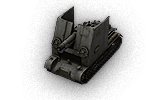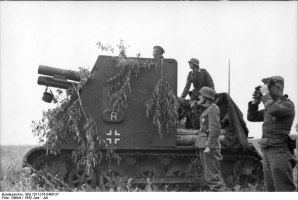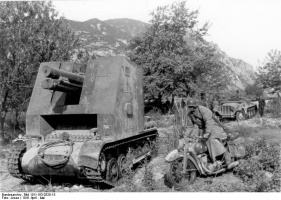Sturmpanzer I Bison
Bison_I (Stock)
| 48500 價格 |
| 130 血量 |
| 6.72 / 7 公斤重量 |
- 車長
| 13/13/13 前/側/後,毫米車身裝甲 |
| 0/0/0 前/側/後,毫米砲塔裝甲 |
| 60 匹馬力引擎功率 |
| 40 公里/小時最高時速 |
| 14 度/秒迴轉速度 |
| 350 標準砲彈殺傷力 |
| 75 毫米標準砲彈穿透力 |
| 15.6 完全裝填的時間 |
| 16 度/秒砲塔迴轉速度 |
| 330 公尺可視範圍 |
| 265 公尺訊號範圍 |

Compatible Equipment
Compatible Consumables
Player Opinion
Pros and Cons
Pros:
- Gun range: 600 m
- High damage and penetration
- Large splash radius for its tier
- High shell trajectory
Cons:
- Poor traverse speed
- Slow shell speed
- Very short range
- Slow reload time
- Slow aim time
Performance
The Bison differentiates itself from the other tier 3 SPGs by firing bigger shells with a slower rate of fire. A direct hit is fatal to most of the opponents it faces. The slow rate of fire is painful, but what really hurts is the time it takes to aim on targets.
The Bison can use two kinds of HE ammunition. The second one does much more damage, but also costs a lot more credits. They both take up the same amount of space however, so don't bother with the cheaper HE shells.
If you're looking for an SPG to learn the ropes of the class with, you're probably better off not going with this one, but if you're experienced with higher tier artillery already, then you're probably already used to slow reload times. Regardless, if you don't like the Bison, it doesn't take long to get through it.
The Bison is a very slow SPG, having a low turning rate, acceleration, and top speed. It also doesn't hold too many of shells, so firing erratically is ill-advised. The Bison does, however, have an excellent firing angle at long ranges, allowing you to shoot if an enemy is completely behind cover. Also, the Bison can one-shot any tier 2-3 scouts with ease, and any tier 4 scouts with 75% health or lower. Missing in close quarters engagements will prove lethal, however, due to its very slow rate of fire.
Be aware that using the HEAT shells on the Bison, the penetration goes up to a whopping 185. This means that the tank could penetrate and do full damage to any tank in the game, assuming the shot hits the right spot. However, take into account the very low accuracy on the gun when trying to do this.
In all, consider the Bison the T92 of tier 3 artillery. Although it has a very poor aim time, rate of fire and accuracy, it has a huge splash radius, damage and penetration that will be sure to severely damage or destroy most tanks it fires at. This makes this SPG paradoxically better the higher tier it gets; as the tanks get slower, this artillery gets more effective - and can easily penetrate even a KV-1 if you hit the right spots.
Early Research
- The Maybach HL 38 TR engine carries over from the Leichttraktor, so you can install it immediately.
- Your best bet is likely to research the upgraded suspension first.
Historical Info
The chassis was overloaded and breakdowns were frequent. The vehicle's extreme height and lack of on-board ammunition were severe tactical drawbacks.
Thirty-eight were produced in February 1940, by Alkett. Thirty-six of these were organized into independent schwere Infanteriegeschütz-Kompanie ("Self-propelled Heavy Infantry Gun Companies"); mot.S. Numbers 701-706 and these were assigned to the 1st, 2nd, 5th, 7th, 9th, and 10th Panzer Divisions in the Battle of France[1] as well as Operation Barbarossa[2]. The 705th and 706th were destroyed during Operation Barbarossa, belonging to the 7th and 10th Panzer Divisions respectively. Of the remaining companies, only the 701st participated in the opening stages of the subsequent Case Blue in 1942, although it, and its parent 9th Panzer Division, were transferred to the Army Group Center by the end of the summer of 1942[3]. The last reference to them is with the 704th Company of the 5th Panzer Division during the middle of 1943[4].
Historical Gallery
Sources and External Links
| Light Tanks | |
| Medium Tanks | |
| Heavy Tanks | |
| Tank Destroyers | |
| Self-Propelled Artillery |
| USA | |
| UK | |
| Germany | |
| USSR | |
| China | |
| Japan |

